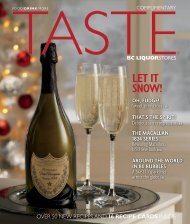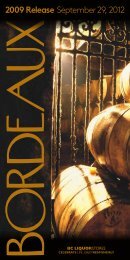You also want an ePaper? Increase the reach of your titles
YUMPU automatically turns print PDFs into web optimized ePapers that Google loves.
y Kim Giesbrecht<br />
analogous terms. Some of the more<br />
specific terms are unusual (plastic, kerosene)<br />
when first experienced, while others<br />
are just plain funny (wet dog, sweaty).<br />
Some of these terms are references to<br />
wine faults or defects, although most are<br />
just a guide for sensory evaluation.<br />
To get into the swing of things,<br />
use the wheel and give your nose some<br />
practice by completing some of the<br />
following exercises:<br />
1) Select and assess wines with large<br />
differences and contrasts in flavour.<br />
2) Make your own wine aroma training<br />
kit by adding a drop of aroma to<br />
vials of neutral box wine. For<br />
example, add a drop of lemon juice<br />
to one sample, a bit of ground clove<br />
or vanilla extract to others.<br />
3) Purchase a professional aroma kit, for<br />
example, Le Nez du Vin, although it<br />
is not inexpensive.<br />
4) Familiarize yourself with the aromas,<br />
most can be found in a supermarket<br />
and mimicked.<br />
5) Some wineries, Mission Hill for<br />
example, have garden tours set up,<br />
based on certain varietals, specifically<br />
for the purpose of connecting<br />
the natural garden scents to aromas<br />
found in wine.<br />
Beginners sometimes find white<br />
wines a little easier to evaluate, so if you<br />
want to try some wines start by selecting<br />
oaky, buttery Chardonnay (most<br />
Australian or California will do), an<br />
herbaceous Sauvignon Blanc (New<br />
Zealand is classic) and an aromatic<br />
Riesling or Gewürztraminer from<br />
<strong>BC</strong>, Alsace, Chile or Germany.<br />
Temperature plays an important part,<br />
so do not evaluate your white wines too<br />
chilled as this can mute the aromas. If you<br />
varietal sceNts aNd seNsibility<br />
The more renowned grape varieties have some commonly found aromas and are<br />
noted for each. Keep in mind the climate, region, harvest, production and maturation<br />
decisions all have a significant impact on the wine’s character. other common taste<br />
descriptors are minerality, earthiness and “terroir”.<br />
CABERnEt – blackcurrant, cherry, black fruits, bell pepper, green spices<br />
mERLOt – plum, red and black fruits, green spices, floral<br />
ZinFAndEL – black fruits, blackberry/briary notes, plums, often jammy, black spices<br />
SyRAh/ShiRAZ – black fruits, black spices, especially white and black pepper<br />
pinOt nOiR – cherry, red fruits, floral, herbs, beetroot<br />
RiESLing – stone fruit, peach, green or citrus fruit, honey, petrol<br />
gEwüRZtRAminER – lychee, floral (rose), spice<br />
SAUVignOn BLAnC – gooseberry, lime and grapefruit<br />
ChARdOnnAy – cool climate: apple, citrus fruit; warm climate: tropical fruit and melon<br />
With increasing proportion of malolactic fermentation, Chardonnay loses its green apple<br />
and takes on buttery and creamy notes.<br />
OAK Aging – imparts wines with vanilla, nutty or spiciness<br />
mAtURity – Wine and aromas transform with time and as wine ages the fruity,<br />
primary aromas evolve into secondary, tertiary aromas becoming more earthy, autumnal<br />
and animalistic.<br />
COmpLExity – layered, intertwined menagerie and elusive bouquets that are part of<br />
the intrigue and beguiling nature of fine wines<br />
if you encounter complexity, you can consider yourself “bitten.”<br />
experience any difficulty, swirl the wine<br />
in the glass to release the aromas, take a<br />
good whiff and close your eyes honing<br />
in on the aromas. Keep it simple and<br />
start with fruit, wood or earth. You can<br />
venture out when you start detecting some<br />
key aromas and gain some familiarity.<br />
Some wines are fairly neutral, without<br />
pronounced defining aromas, so relax if<br />
you come across this or slurp some air in<br />
through the mouth, this helps to release<br />
aromas and taste.<br />
When you go to a wine tasting you<br />
will encounter people with varying<br />
degrees of wine knowledge and tasting<br />
skill. If you can approach an informed<br />
taster willing to share their knowledge it<br />
can be very educational. With practice<br />
and a little guidance it is simply just a<br />
matter of time before you reach a level<br />
of comfort. The world of wine is<br />
fascinating, exciting and fun and what<br />
a road to travel!<br />
Wine Aroma Wheel copyright 1990, 1992<br />
AC Noble www.winearomawheel.com<br />
Laminated plastic copies of the wine aroma<br />
wheel may be obtained in Canada by emailing<br />
innovinum@cogeco.ca<br />
TASTE 47





